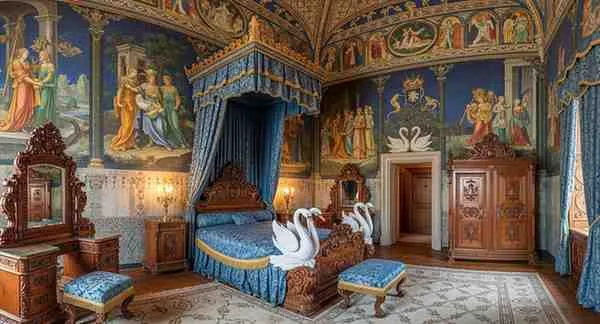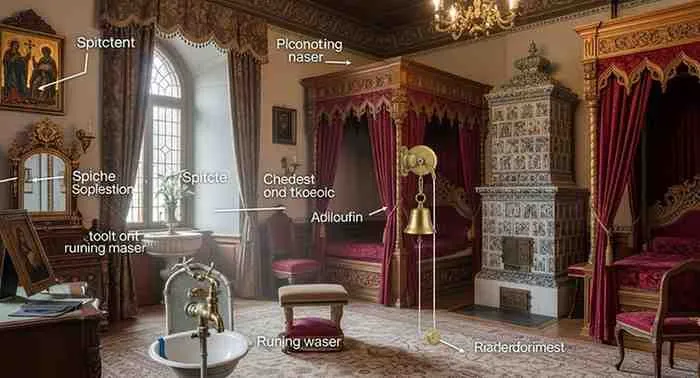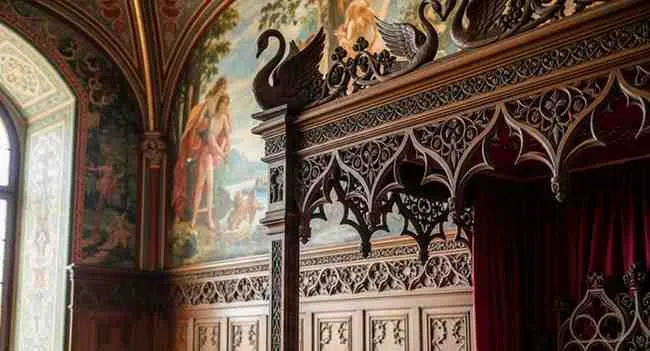Introduction
Nestled in the heart of Bavaria’s Alpine landscape stands one of the world’s most romantic castles—Neuschwanstein. Yet beyond its fairy-tale exterior lies an interior of extraordinary opulence and symbolism, nowhere more evident than in King Ludwig II’s personal bedroom. This intimate chamber, where Bavaria’s enigmatic “Mad King” sought refuge from the modern world, represents the pinnacle of 19th-century romantic imagination merged with neo-Gothic craftsmanship.
The Neuschwanstein castle bedroom is not merely a place where a monarch slept—it’s a carefully orchestrated theatrical space where every carved detail, every painted mural, and every decorative element tells a story. From the elaborate oak bed canopy adorned with intricate Gothic spires to the stunning Tristan and Isolde murals that dominate the walls, Ludwig II created a sanctuary that embodied his obsessions: medieval romance, Wagnerian opera, and the mystical symbolism of the swan.
What makes King Ludwig II bedroom Neuschwanstein particularly fascinating is how it reflects the king’s complex personality and visionary—some would say obsessive—attention to detail. Unlike the grand state rooms designed to impress visitors, this private space reveals Ludwig’s inner world: his love of Wagner’s operas, his identification with legendary tragic heroes, and his desire to escape into a realm of medieval fantasy.
In this comprehensive exploration, you’ll discover the architectural marvels, symbolic meanings, and technological innovations that make this royal bedroom one of Europe’s most remarkable historic interiors. From the neo-Gothic furniture that took master craftsmen years to complete, to the surprisingly modern amenities Ludwig installed for his comfort, we’ll unveil every fascinating detail of this extraordinary space—and understand why, though Ludwig spent only a few nights here before his mysterious death, this bedroom remains an enduring symbol of romantic excess and artistic vision.
Neuschwanstein Castle: Context and King Ludwig II’s Vision
Before examining the bedroom itself, understanding the castle’s creation and its creator’s motivations provides essential context for appreciating this remarkable space.

The Creation of a Fairy-Tale Castle
Historical Background:
Neuschwanstein Castle, whose name translates to “New Swan Stone Castle,” was commissioned by King Ludwig II of Bavaria in 1869. Construction began on the ruins of two older castles—Vorderhohenschwangau and Hinterhohenschwangau—perched on a rugged hill above the village of Hohenschwangau in southwest Bavaria.
Ludwig II’s Vision:
The castle was conceived as:
- A personal refuge from political pressures and public life
- A tribute to Richard Wagner and his operatic works
- A recreation of an idealized medieval castle
- A manifestation of divine right monarchy in an age of increasing democracy
The Reality vs. The Dream:
Tragically, Ludwig II lived to see only partial completion of his masterpiece:
- Construction lasted from 1869 to his death in 1886
- Ludwig spent only 172 days in residence
- He slept in the bedroom for fewer than 20 nights
- The castle was opened to tourists just seven weeks after his death in 1886
- Construction continued until 1892, though many planned features were never built
Architectural Style:
Neuschwanstein combines multiple historical influences:
- Neo-Romanesque elements in the exterior architecture
- Neo-Gothic interior design, particularly in private apartments
- Byzantine influences in the Throne Hall
- Wagnerian operatic themes throughout decorative programs
This eclectic approach, orchestrated by theatrical set designer Christian Jank rather than a traditional architect, created something unprecedented—a building that was simultaneously medieval in inspiration and thoroughly modern in construction and amenities.
King Ludwig II: The Romantic Monarch
Ludwig’s Character and Obsessions:
Born in 1845, Ludwig II ascended to the Bavarian throne at age 18 in 1864. His reign was marked by:
Artistic Passions:
- Profound devotion to Richard Wagner’s music and operas
- Identification with legendary and tragic figures
- Preference for solitude and nocturnal activities
- Obsessive attention to aesthetic detail
Political Challenges:
- Bavarian defeat in the Austro-Prussian War (1866)
- Forced alliance with Prussia (1870)
- Loss of Bavarian independence to the German Empire (1871)
- Growing criticism of his expensive building projects
Psychological Complexity: Ludwig’s mental state remains debated:
- Contemporaries labeled him “mad” (though modern historians question this diagnosis)
- Exhibited increasing reclusiveness and eccentric behavior
- Possible depression and anxiety
- His homosexuality (then scandalous) may have contributed to his isolation
The Role of Fantasy:
For Ludwig, castle building represented:
- Escape from political disappointments and modernization
- Creation of worlds where medieval chivalry and romantic ideals prevailed
- Physical manifestations of Wagner’s operatic universes
- Private theaters where he could be the sole audience
Understanding Ludwig’s psychology is essential to interpreting his bedroom—it wasn’t designed for public display but as an intimate refuge where he could inhabit his romantic fantasies completely.
Wagner’s Influence on Neuschwanstein’s Design
The Wagner Connection:
Richard Wagner (1813-1883), the revolutionary German composer, profoundly shaped Ludwig’s worldview and Neuschwanstein’s design.
Ludwig as Wagner’s Patron:
- Met Wagner in 1864, shortly after becoming king
- Provided massive financial support, rescuing Wagner from debt
- Built the Bayreuth Festspielhaus for Wagner’s operas
- Attended Wagner performances repeatedly, often alone in royal boxes
Wagnerian Themes in Neuschwanstein:
The castle essentially functions as a three-dimensional Wagner opera:
- Singers’ Hall: Inspired by Wagner’s “Tannhäuser”
- Throne Hall: References “Parsifal” and the Holy Grail
- Royal Bedroom: Dominated by “Tristan und Isolde” imagery
This Wagner-inspired interior design transformed the castle from mere architecture into an immersive artistic experience—a concept remarkably ahead of its time and still influential in themed environment design today.
The Royal Bedroom: Architectural and Design Details

The bedroom itself occupies a central position in Ludwig’s private apartments, located on the third floor of the Palas (main residential building). Every element was carefully designed to create a cohesive aesthetic and symbolic program.
Neo-Gothic Style and Overall Design Philosophy
What is Neo-Gothic?
The neo-Gothic bedroom design style represents a 19th-century revival of medieval Gothic architecture and decorative arts, characterized by:
- Pointed arches and elaborate tracery
- Rich wood carvings with intricate detail
- Vertical emphasis and soaring proportions
- Religious and chivalric imagery
- Deep, rich colors (particularly blues, reds, and gold)
The Bedroom’s Neo-Gothic Elements:
Ludwig’s bedroom exemplifies this style through:
Architectural Features:
- Vaulted ceiling with painted stars on blue background (evoking medieval church interiors)
- Pointed arch doorways
- Gothic tracery patterns throughout woodwork
- Vertical emphasis in furniture design
Materials and Craftsmanship:
- Carved oak throughout (bed, washstand, prayer desk)
- Intricate hand-carving requiring years of skilled labor
- Gold leaf highlighting on carvings
- Rich textiles including silk, velvet, and embroidered fabrics
Color Palette:
- Deep royal blue as the dominant color
- Gold accents throughout
- Rich burgundy and crimson in textiles
- White marble in the washbasin area
Scale and Proportion:
Despite being a private bedroom, the space impresses with:
- High vaulted ceiling creating vertical drama
- Substantial furniture pieces that command attention
- Intimate overall dimensions (approximately 30 square meters)
- Successful balance between grandeur and livability
The Magnificent Carved Oak Bed and Canopy
The Centerpiece:
The royal bed canopy Neuschwanstein stands as the room’s most spectacular feature—a masterpiece of Gothic Revival woodcarving that took master carpenters years to complete.
Design Specifications:
The Canopy Structure:
- Elaborately carved oak superstructure
- Gothic spires and pinnacles reaching toward the ceiling
- Delicate tracery resembling medieval cathedral architecture
- Multiple tiers creating vertical drama
Swan Motifs:
The swan motifs Neuschwanstein bedroom features throughout are particularly prominent on the bed:
- Carved swans integrated into the canopy design
- Swan symbolism (more on this below)
- Repeated in various scales and positions
- Connected to Ludwig’s personal heraldry and the castle’s name
The Headboard:
Behind the sleeping area:
- Richly carved oak panel
- Architectural elements mimicking church reredos (decorative screens)
- Additional Gothic tracery
- Religious imagery (crosses, saints)
Construction Details:
The bed’s creation involved:
- Multiple master woodcarvers working for several years
- Hand-carving every detail (no machine replication)
- Careful selection of oak for grain patterns
- Gold leaf application to highlight carved elements
- Integration with the room’s overall design scheme
Textiles:
The bed featured:
- Heavy silk and velvet bed curtains (now replaced with period-appropriate reproductions)
- Embroidered bed linens with monograms
- Multiple layers including coverlets and pillows
- Rich blue and gold color scheme matching the room
Practical Considerations:
Despite its ornate appearance, the bed was:
- Functional and comfortable by 19th-century standards
- Fitted with quality mattress and bedding
- Positioned to optimize light and views
- Equipped with bed curtains for warmth and privacy
Comparative Context:
While elaborate royal beds were common in European palaces, Ludwig’s bed stands out for:
- Extreme degree of Gothic revival styling
- Unified symbolic program
- Integration with room architecture
- Single-minded artistic vision rather than committee design
Tristan and Isolde: The Dominant Mural Program
The Wagner Connection:
The bedroom’s walls feature extensive murals depicting scenes from Richard Wagner’s opera “Tristan und Isolde,” based on the medieval romance of doomed lovers.
Why Tristan and Isolde?
Ludwig chose this particular Wagner opera for his most private space because:
Personal Identification:
- Ludwig saw himself in Tristan—a noble figure caught between duty and impossible love
- The theme of forbidden, unconsummated passion resonated with Ludwig’s own situation
- Tristan’s ultimate escape through death may have appealed to Ludwig’s melancholy
- The medieval setting aligned with Ludwig’s romantic worldview
The Love Potion Theme: Wagner’s opera centers on a magic potion that causes irresistible, tragic love—a metaphor for:
- Fate overpowering individual will
- Love as both transcendent and destructive
- Escape from mundane reality
- Passion that can only be fulfilled in death
Artistic Execution:
The Tristan and Isolde mural Neuschwanstein features were painted by multiple artists:
Key Scenes Depicted:
- The Love Potion: Tristan and Isolde accidentally consuming the magic potion aboard ship
- The Love Garden: Secret nighttime meetings between the lovers
- Discovery and Separation: King Mark discovering the affair
- Tristan’s Death: The tragic conclusion
Artistic Style:
The murals exhibit:
- Late Romantic painting style
- Rich, saturated colors
- Dramatic emotional expression
- Detailed medieval costumes and settings
- Theatrical staging reminiscent of opera productions
Symbolism Layered Throughout:
Beyond the obvious narrative:
- Night and moonlight settings (Ludwig was famously nocturnal)
- Garden and natural settings (representing paradise or escape)
- Ships and travel (journey, transition, fate)
- Flowers with symbolic meanings (roses for love, lilies for purity)
Viewing Experience:
From his bed, Ludwig would be surrounded by:
- The tragic love story unfolding on multiple walls
- Constant reminders of Wagnerian themes
- A visual opera house created just for him
- Invitation to imagine himself as Tristan in his own romantic tragedy
Preservation:
Today’s visitors see:
- Carefully conserved original murals
- Some restoration work to address aging and previous damage
- Controlled lighting to prevent further deterioration
- The same emotional impact Ludwig intended
Additional Decorative Elements and Furniture
The Prayer Desk:
Religious devotion played a significant role in Ludwig’s life, reflected in:
- Elaborately carved oak prayer desk (prie-dieu)
- Gothic architectural details matching the bed
- Positioned near the door to the private chapel
- Used for Ludwig’s regular devotional practices
The Washstand:
A masterpiece of functional Gothic Revival design:
- Carved oak structure
- White marble basin and surfaces
- Running water—a modern luxury in the 1880s
- Integrated mirror with Gothic frame
- Storage for toiletries in carved cabinets below
Seating and Tables:
Additional furniture included:
- High-backed Gothic chairs with carved details
- Small tables for personal items
- Reading stand for books
- All pieces coordinated in style and execution
Textiles and Soft Furnishings:
Beyond the bed:
- Heavy velvet curtains at windows
- Embroidered table covers
- Carpets with medieval-inspired patterns
- Cushions in coordinating fabrics
Lighting:
19th century lighting in Ludwig’s bedroom:
- Ornate candelabra and candlesticks
- Oil lamps for reading
- Later gas lighting (modern for the era)
- Carefully designed to create atmospheric illumination
Windows and Views:
The bedroom windows offered:
- Spectacular Alpine vistas
- Natural light during day
- Connection to the romantic landscape
- Views toward Hohenschwangau Castle (Ludwig’s childhood home)
Ceiling Treatment:
Above, the vaulted ceiling featured:
- Deep blue painted surface
- Golden stars creating a night sky effect
- Reminder of medieval church ceilings
- Symbolic connection to heaven and divine order
Technological Innovations in the Private Apartments
Despite its medieval aesthetic, Neuschwanstein incorporated remarkably advanced technology for the 1880s—demonstrating Ludwig’s appreciation for modern comfort within his historical fantasy.

Running Water and Modern Plumbing
Advanced for Its Time:
When visitors ask “did Neuschwanstein Castle have running water when Ludwig II lived there,” the answer reveals Ludwig’s forward thinking.
Water System Features:
Hot and Cold Running Water:
- Both hot and cold water available in the bedroom washstand
- Ahead of most European palaces
- Supplied from a spring 200 meters above the castle
- Gravity-fed system requiring no pumps
Bathrooms:
Adjacent to the bedroom:
- Multiple bathrooms with flush toilets
- Porcelain fixtures
- Decorative tile work
- Modern by 1880s standards, extraordinary for a “medieval” castle
Technical Achievement:
The water system required:
- Extensive underground piping
- Reservoir construction
- Heating system for hot water
- Engineering expertise unusual for castle construction
Symbolic Tension:
This creates fascinating contrast:
- Medieval aesthetic throughout
- Modern plumbing hidden within walls
- Ludwig wanted medieval appearance with modern comfort
- No desire to actually live like a medieval knight
Heating and Climate Control
Central Heating System:
The castle featured:
- Central heating via hot air ducts
- Warm air distributed through decorative grates
- Coal-fired furnaces in basement
- Relatively even temperature throughout
Bedroom Climate:
Specific features for Ludwig’s comfort:
- Heat vents integrated into Gothic architectural elements
- Ability to adjust temperature
- Insulated windows with heavy curtains
- Fireplace for additional warmth and ambiance
Technological Integration:
Ludwig insisted on:
- Heating that wouldn’t damage artwork or wood carvings
- Systems hidden from view (maintaining medieval illusion)
- Reliable operation during harsh Bavarian winters
- Comfort levels matching modern hotels of the era
Communication and Service Systems
Servant Call System:
Ludwig could summon servants via:
- Electric bell system throughout private apartments
- Ahead of most European residences
- Bells in service areas alerted staff
- Minimal intrusion on Ludwig’s privacy
Service Passages:
Behind-the-scenes efficiency:
- Hidden corridors for servant movement
- Staff could provide service without being seen
- Delivery of meals, hot water, clean linens without disturbing Ludwig
- Supported his desire for solitude
Kitchen Communication:
Food delivery system included:
- Dumbwaiter from kitchen floors below
- Warming cabinets to keep food hot
- Elaborate service procedures to ensure privacy
- Ludwig often ate alone, even in his own castle
Additional Modern Amenities
Lighting Evolution:
The castle’s illumination advanced during construction:
- Initial candles and oil lamps
- Gas lighting installation in some rooms
- Electric lighting planned (never fully implemented before Ludwig’s death)
- Emphasis on creating appropriate ambiance, not just illumination
Telephone System:
Ludwig’s private apartments featured:
- Early telephone connections
- Communication with nearby Hohenschwangau Castle
- One of the first castle telephone installations in Europe
- Practical tool despite medieval aesthetic
Innovation Philosophy:
Ludwig’s approach to technology:
- Embraced modern convenience where useful
- Insisted technology be invisible or disguised
- Never allowed practical concerns to compromise aesthetic vision
- Created what might be called “steampunk” avant la lettre—medieval exterior, modern interior systems
Symbolism and Cultural Significance
Every element in King Ludwig II’s bedroom carried symbolic weight, creating layers of meaning that transformed the space into a three-dimensional manifesto of romantic ideals.

The Swan: Personal Emblem and Multifaceted Symbol
Ubiquitous Swan Imagery:
The swan appears throughout the bedroom in:
- Carved oak bed decorations
- Mural backgrounds
- Furniture details
- Textile patterns
- Even sink fixtures
Multiple Symbolic Meanings:
Connection to Wagner:
- Swan appears in multiple Wagner operas
- “Lohengrin” features the Swan Knight (Schwanenritter)
- Ludwig saw himself as Lohengrin, the mysterious knight
- Swans pull Lohengrin’s boat in the opera
Medieval Legend:
- Swans associated with transformation and mystery
- Connection to the House of Schwangau (Swan Region)
- Historical legends of the Swan Knight
- Heraldic significance in Bavarian aristocracy
Personal Identification:
- Ludwig as the “Swan King”
- Symbol of purity and romantic isolation
- Swan’s dual nature (graceful above water, frantically paddling below) mirrored Ludwig’s public vs. private life
- Swan’s white beauty against dark water reflected Ludwig’s self-image as pure idealist in corrupt world
The Castle’s Name:
- “Neuschwanstein” literally means “New Swan Stone”
- Replacing older Schwanstein (Swan Stone) castle
- Entire castle conceived as monument to swan symbolism
- Bedroom as epicenter of this symbolic program
Medieval Romance and Chivalric Ideals
Idealized Middle Ages:
The bedroom embodied Ludwig’s vision of medieval chivalry:
Themes Presented:
- Pure, impossible love (Tristan and Isolde)
- Noble suffering and sacrifice
- Courtly manners and refined sensibility
- Rejection of modern materialism
- Faith, honor, and loyalty
Historical Reality vs. Ludwig’s Fantasy:
Important to note:
- Medieval reality was quite different from Ludwig’s vision
- He created an idealized, romanticized version
- Based on 19th-century opera and literature, not historical accuracy
- Perfectly acceptable—this was about emotion and meaning, not archaeology
Escape from Modernity:
The medieval aesthetic represented:
- Rejection of industrial revolution and modernization
- Resistance to Bavarian loss of independence
- Retreat into imagined past of German greatness
- Personal refuge from responsibilities Ludwig found overwhelming
Religious Imagery and the Adjacent Chapel
Sacred Space Connection:
The bedroom’s proximity to Ludwig’s private chapel was significant:
The Private Chapel:
- Directly connected to the bedroom via small door
- Neo-Gothic design matching bedroom
- Elaborately decorated altar
- Small, intimate space for personal devotion
Religious Elements in the Bedroom:
Carved Details:
- Crosses integrated into bed design
- Saints depicted in woodwork
- Biblical motifs in decorative programs
- Prayer desk as prominent furniture piece
Symbolic Integration:
The combination of sacred and secular themes:
- Tristan and Isolde (romantic, operatic) alongside religious imagery
- No contradiction in Ludwig’s worldview
- Both represented transcendent, spiritual experiences
- Medieval Catholicism and Wagnerian mythology merged in romantic synthesis
Daily Devotions:
Ludwig’s religious practices:
- Regular prayer at his prayer desk
- Attendance at masses in the chapel
- Collection of relics and religious art
- Sincere faith alongside theatrical religiosity
Interpretive Questions:
Historians debate:
- Was Ludwig’s religious devotion genuine or aesthetic?
- Did he see contradiction between Wagner’s paganism and Christianity?
- How did homosexuality intersect with his Catholic faith?
- Was the bedroom’s religious imagery comfort or performance?
Most likely: a complex mixture of sincere faith, aesthetic appreciation, and psychological need—much like Ludwig himself.
The Bedroom as Theatrical Space
Staged Reality:
Ludwig’s bedroom functioned as:
- Personal theater with audience of one
- Set for Ludwig to perform the role of romantic hero
- Space where fantasy and reality merged
- Escape hatch from the disappointments of real life
Performative Aspects:
Even alone, Ludwig:
- Dressed in historical costumes
- Staged midnight “audiences” with imaginary companions
- Read romantic literature and opera libretti
- Lived his fantasies in carefully designed settings
Psychological Function:
The bedroom provided:
- Safe space for Ludwig’s inner life
- Physical manifestation of his psychological needs
- Control unavailable in his political life
- Refuge from judgment and incomprehension
Contemporary Relevance:
Ludwig’s approach anticipates:
- Modern themed environments and immersive experiences
- Virtual reality and escapist technologies
- Fan cultures and cosplay
- Understanding of physical space’s psychological impact
The Visitor Experience: Seeing the Bedroom Today
Over 1.5 million tourists visit Neuschwanstein annually, with Ludwig’s bedroom consistently ranking as a highlight of the guided tours.
What Visitors Notice and Experience
First Impressions:
Tourists entering the bedroom typically react to:
Visual Overwhelming:
- Sheer density of decoration
- Richness of colors (especially the blues and golds)
- Intricacy of the woodcarvings
- Dramatically of the bed canopy
Emotional Responses:
Common visitor reactions:
- Awe at the craftsmanship
- Surprise at the relatively intimate scale
- Sadness knowing Ludwig barely used it
- Fascination with the Tristan and Isolde murals
Unexpected Elements:
Visitors often surprised by:
- Modern plumbing fixtures
- Relatively small room size (compared to Versailles-style palaces)
- Focus on Wagner rather than traditional royal imagery
- Personal, intimate quality versus state grandeur
Photography Restrictions:
Currently:
- No photography allowed inside the castle
- Protects fragile interiors from flash damage
- Maintains mystery and encourages focus during tour
- Official photographs available for purchase
Preservation and Restoration Efforts
Conservation Challenges:
Maintaining the bedroom requires:
Climate Control:
- Managing humidity levels
- Preventing wood expansion/contraction
- Protecting murals from moisture damage
- Balancing preservation with visitor access
Wear from Tourism:
With massive visitor numbers:
- Foot traffic causes vibration and dust
- Body heat and humidity affect environment
- Requires constant monitoring and maintenance
- Limiting visitor numbers to protect interiors
Restoration Projects:
Over the decades:
- Careful cleaning of murals
- Wood conservation and stabilization
- Textile reproduction (original fabrics too fragile)
- Historical research to ensure accuracy
Documentation:
Modern preservation includes:
- 3D scanning of carvings
- High-resolution photography
- Chemical analysis of paints and materials
- Creating detailed records for future restoration
Balancing Access and Preservation:
The ongoing challenge:
- Tourism provides funding for maintenance
- But visitor impact threatens preservation
- Timed entry and limited group sizes help
- Potential future: more limited access to protect the space
Tour Experience and Access
Current Visiting Conditions:
Guided Tours Only:
- Approximately 35-minute tours
- Available in multiple languages (or audio guides)
- Groups of 25-35 people
- Advance booking strongly recommended (tours sell out)
What You’ll See:
The tour includes:
- Ludwig’s bedroom (brief stop, several minutes)
- Other private apartments
- Throne Hall
- Singers’ Hall
- Multiple other decorated rooms
Time in the Bedroom:
Visitors spend:
- Approximately 2-3 minutes in the actual bedroom
- View from doorway area (don’t enter sleeping chamber itself)
- Guide provides historical context and points out key features
- Limited time due to visitor volume
Accessibility:
Important to note:
- Lots of stairs (no elevator to upper floors)
- Not wheelchair accessible throughout
- Can be challenging for those with mobility issues
- Alternative: visit lower levels only, view comprehensive photo exhibitions
Best Visiting Practices:
To maximize your experience:
- Book tickets online weeks in advance
- Arrive early (tours depart on schedule)
- Study bedroom details beforehand to know what to look for
- Listen carefully to guide (you’ll miss details otherwise)
- Visit off-season if possible (fewer crowds)
Comparative Context: Ludwig’s Bedroom vs. Other Royal Spaces
Placing Neuschwanstein’s bedroom in broader context illuminates what makes it unique among European royal residences.
Comparison with Other Ludwig II Castles
Linderhof Palace:
Ludwig’s other major project featured:
- Rococo revival style (vs. Neo-Gothic)
- Smaller, more intimate scale
- Bedroom focused on French absolutism themes
- Different but equally elaborate decorative program
Herrenchiemsee Palace:
Ludwig’s tribute to Versailles included:
- Bedroom modeled on Louis XIV’s
- Grand Baroque splendor
- More public, ceremonial character
- Less personal than Neuschwanstein
What Makes Neuschwanstein’s Bedroom Special:
Compared to Ludwig’s other bedrooms:
- Most intensely personal and symbolic
- Most thoroughly Gothic Revival
- Most Wagner-focused
- Most complete realization of Ludwig’s medieval fantasies
European Royal Bedroom Traditions
Versailles and French Influence:
Traditional royal bedrooms featured:
- Bed as throne (ceremonial space, not just sleeping)
- Public levées (morning rituals with courtiers present)
- Symbols of absolute power
- Grand, imposing scale
Ludwig’s Departure:
His bedroom differs by:
- Completely private (no court ceremonies)
- Focus on personal mythology rather than state power
- Romantic/artistic rather than political symbolism
- Intimate scale prioritizing comfort over grandeur
British Royal Bedrooms:
Windsor and Buckingham Palace bedrooms:
- Generally more restrained decoration
- Focus on comfort and family life (especially Victoria era)
- Less theatrical than Continental examples
- Practical Victorian sensibilities
Ludwig’s Excess:
By comparison, Neuschwanstein’s bedroom:
- Far more decoratively dense
- Unabashedly theatrical
- No concession to “good taste” or restraint
- Pure expression of personal vision
19th Century Luxury Bedroom Standards
What Was Normal for the Era:
Wealthy 19th-century bedrooms typically featured:
- Substantial wooden furniture
- Rich textiles and draperies
- Decorative wall treatments (wallpaper or murals)
- Fine carpets or rugs
- Modern plumbing (if newly built)
Ludwig’s Extremes:
His bedroom exceeded norms by:
- Years of craftsman work on single pieces
- Unified thematic program
- Integration of art, architecture, and furnishing
- No expense spared on any detail
- Complete commitment to aesthetic vision
Cost Considerations:
While exact figures are debated:
- Ludwig’s building projects bankrupted his personal finances
- Bedroom represents thousands of hours of skilled labor
- Materials imported from across Europe
- Modern equivalent cost: millions of dollars for single room
Comparable Spaces:
Few historical bedrooms match Neuschwanstein’s intensity:
- Some Bavarian rococo bedrooms (Residenz Munich)
- Napoleon’s bedrooms (but more Empire style)
- Russian imperial bedrooms (different aesthetic)
- Generally, Ludwig’s bedroom stands nearly alone in its particular combination of characteristics
Historical Anecdotes and Ludwig’s Use of the Space
Though Ludwig spent minimal time at Neuschwanstein, the bedroom witnessed significant moments and reveals much about the king’s character.
Ludwig’s Brief Residency
Timeline of Occupation:
Construction Period:
- Bedroom completed in 1884
- Ludwig first slept there in 1884
- Total nights spent: fewer than 20
- Last visit: months before his death in June 1886
Why So Brief?
Multiple factors limited Ludwig’s use:
- Castle still under construction during his lifetime
- Other palaces (Linderhof, Herrenchiemsee) competing for his time
- Growing political and financial crises
- His mysterious death ended any long-term residence
The Tragedy:
Most poignant aspect:
- Ludwig poured creative energy and massive resources into this bedroom
- Supervised every detail of its design and execution
- Barely experienced the completed space
- Died before truly inhabiting his dream
Documented Behaviors and Habits
Nocturnal Lifestyle:
Ludwig’s bedroom habits included:
- Sleeping during the day
- Active at night (explaining the ceiling’s starry sky motif)
- Reading and contemplation in the midnight hours
- Sometimes remaining in nightclothes until evening
Solitary Occupation:
Reports from servants:
- Ludwig typically alone in his chambers
- Sometimes spoke to imaginary companions
- Read Wagner libretti and medieval romances
- Maintained elaborate personal grooming rituals
Theatrical Performances:
Ludwig occasionally:
- Had passages from operas read aloud
- Staged small performances for himself
- Dressed in historical costumes
- Lived out scenes from his favorite legends
Religious Observance:
Daily practices:
- Morning prayers at the prayer desk
- Visits to the adjacent chapel
- Reading religious texts
- Collection of religious art and relics
The Mysterious Death and Its Aftermath
Final Days:
In June 1886:
- Ludwig declared insane by doctors who never examined him
- Removed from Neuschwanstein to Berg Castle
- Found dead in Lake Starnberg on June 13, 1886
- Official cause: suicide by drowning
- Alternative theories: murder, accidental death
Questions Remain:
The bedroom connection:
- Did Ludwig sense his coming downfall?
- Was the bedroom a last refuge before his removal?
- What were his final thoughts in this space he created?
- How did the bedroom’s romantic tragedy themes foreshadow his own end?
Immediate Aftermath:
Following Ludwig’s death:
- Castle opened to tourists within seven weeks
- Bedroom preserved essentially as Ludwig left it
- Became shrine to the deceased king
- Financial pressures required tourist income
The Bedroom as Memorial:
Today, the space functions as:
- Monument to Ludwig’s vision and tragedy
- Time capsule of 1880s royal aesthetics
- Physical evidence of romantic-era psychology
- Tourist attraction funding castle preservation
Key Takeaways: The Significance of Neuschwanstein’s Royal Bedroom
Architectural and Artistic Achievement
Pros of the Design:

Extraordinary Craftsmanship:
- Represents pinnacle of 19th-century woodcarving
- Master craftsmen at the height of their skills
- Each detail hand-executed with obsessive care
- Unified artistic vision rarely achieved in royal spaces
Successful Aesthetic Integration:
- All elements work together thematically
- Color, form, symbol, and function harmonized
- Creates immersive experiential environment
- Demonstrates possibilities of total design
Historical Importance:
- Documents romantic-era aesthetics and psychology
- Preserves Wagner-influenced design philosophy
- Represents last gasp of absolute monarchy’s artistic patronage
- Influences later themed environment design
Technological Innovation:
- Successfully integrated modern systems into historical aesthetic
- Advanced plumbing and heating for the era
- Demonstrated that comfort needn’t compromise style
- Forward-thinking approach to residential technology
Critiques and Limitations
Cons and Controversies:
Aesthetic Overload:
- Some find the decoration excessive or overwhelming
- “Too much” for minimalist or contemporary tastes
- Every surface decorated can feel claustrophobic
- Lack of visual rest areas
Historical Inauthenticity:
- Not actually medieval despite appearance
- Romanticized fantasy rather than historical accuracy
- More Victorian than medieval in sensibility
- Could be criticized as historical theme park
Extravagant Cost:
- Contributed to Ludwig’s financial ruin
- Placed burden on Bavarian state finances
- Arguably irresponsible use of royal resources
- Though tourism now generates massive revenue
Psychological Concerns:
- Bedroom represents escape from reality
- Enabled Ludwig’s retreat from royal responsibilities
- May have reinforced rather than helped his mental struggles
- Questions about art’s role in mental health
Practical Limitations:
- As actual bedroom, arguably impractical
- Difficult to clean and maintain
- Fragile elements unsuited to daily life
- More museum than livable space
Cultural Legacy
Enduring Influence:
Ludwig’s bedroom has inspired:
Design and Architecture:
- Gothic Revival and historicist movements
- Themed environment design
- Integration of narrative into physical



